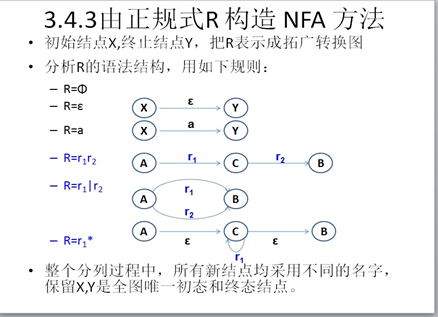实验三 有限自动机的构造与识别
一、实验目标
1、掌握有穷状态自动机的概念;
2、掌握有穷状态自动机的存储及表示方法;
3、掌握有穷状态自动机与正则式之间的关系。
二、实验要求
1、输入正规式;
2、构造该正规式的有穷状态自动机;
3. 以五元组形式输出。

1 #include <stdio.h> 2 #include <string.h> 3 #define N 100 4 char r[N]; 5 int s,t; 6 int q=1; 7 struct f{ 8 char r; 9 int a; 10 int b; 11 }; 12 typedef struct f F; 13 14 F f[50]; 15 int n=0; 16 17 main() 18 { char ch; 19 int p=0; 20 int j; 21 22 printf(" 请输入正规式(以'#'结束): "); 23 do 24 { 25 ch=getchar(); 26 r[p++]=ch; 27 }while (ch!='#'); 28 29 r2nfa(r,0,p-1,0,1); 30 31 printf(" nfa的分列过程如下:"); 32 for (j=0;j<n;j++) 33 { 34 printf(" f(%d, %c)=%d ",f[j].a,f[j].r,f[j].b); 35 } 36 37 system("pause"); 38 39 40 } 41 42 43 r2nfa(char r[],int s,int t,int a,int b) 44 { int i; 45 46 if (t-s==1) 47 { 48 f[n].a=a; 49 f[n].r=r[s]; 50 f[n].b=b; 51 n++; 52 } 53 else 54 { 55 i=lowest(r,s,t); 56 57 if (r[i]=='|') 58 { 59 r2nfa(r,s,i,a,b); 60 r2nfa(r,i+1,t,a,b); 61 } 62 63 else if (r[i]=='.') 64 { 65 q++; 66 r2nfa(r,s,i,a,q); 67 r2nfa(r,i+1,t,q,b); 68 } 69 70 else 71 { 72 q++; 73 74 f[n].a=a; 75 f[n].r='~'; 76 f[n].b=q; 77 n++; 78 79 f[n].a=q; 80 f[n].r='~'; 81 f[n].b=b; 82 n++; 83 84 r2nfa(r,s,t-1,q,q); 85 } 86 } 87 } 88 89 int lowest(char r[],int s,int t) 90 { int i,j; 91 int priority=5; 92 93 for (j=s;(j<t);j++) 94 { 95 switch(r[j]) 96 { 97 case '|': 98 if (priority>1) 99 { 100 i=j; 101 priority=1; 102 } 103 break; 104 case '.': 105 if (priority>2) 106 { 107 i=j; 108 priority=2; 109 } 110 break; 111 case '*': 112 if (priority>3) 113 { 114 i=j; 115 priority=3; 116 } 117 break; 118 default: ; 119 } 120 } 121 return i; 122 }
自动机nfa
状态0(初态)->状态1(终态)的过程
运行结果如图所示:
